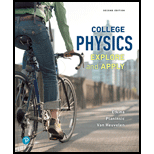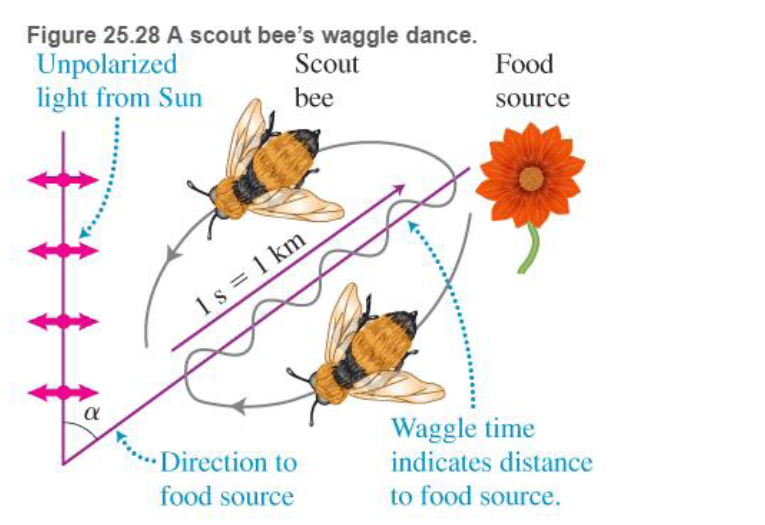
Concept explainers
BIO Amazing honeybees The survival of a bee colony depends on the ability of bee scouts to locate food and to convey that information to the hive. After finding a promising food source, a honeybee scout returns to the hive and uses a waggle dance to tell its worker sisters the direction and distance to the food.
Recall that light coming directly from the Sun is unpolarized. Bees use the direction of the Sun as a reference for their travel. In the hive, the scout bee's waggle dance is in the shape of a flat figure eight (Figure 25.28). The upward direction in the vertical hive represents the direction toward the Sun. The middle line of the scout’s figure eight points in the direction of the food relative to the direction of the Sun. I hus a

Suppose that the scout bee in a waggle dance indicates that a good food source is at a
a. has a flowery odor.
b. has completely unpolarized light coming from it.
c. has completely linearly polarized light coming from it.
d. has partially unpolarized light coming from it.
e. None of these answers
Want to see the full answer?
Check out a sample textbook solution
Chapter 25 Solutions
College Physics
Additional Science Textbook Solutions
Physics for Scientists and Engineers: A Strategic Approach, Vol. 1 (Chs 1-21) (4th Edition)
College Physics: A Strategic Approach (3rd Edition)
Conceptual Physical Science (6th Edition)
Essential University Physics: Volume 2 (3rd Edition)
The Cosmic Perspective
Applied Physics (11th Edition)
- Lunar astronauts placed a reflector on the Moon's Surface, off which a laser beam is periodically reflected. The distance to the Moon is calculated from the round-trip time. (a) To what accuracy in meters can the distance to the Moon be determined, if this time can be measured to 0.100 ns? (b) What percent accuracy is this, given the average distance to the Moon is 3.84108m ?arrow_forwardThe Tunguska event. On June 30, 1908, a meteor burned up and exploded in the atmosphere above the Tunguska River valley in Siberia. It knocked down trees over thousands of square kilometers and started a forest fire, but produced no crater and apparently caused no human casualties. A witness sitting on his doorstep outside the zone of falling trees recalled events in the following sequence. He saw a moving light in the sky, brighter than the Sun and descending at a low angle to the horizon. He felt his face become warm. He felt the ground shake. An invisible agent picked him up and immediately dropped him about a meter from where he had been seated. He heard a very loud protracted rumbling. Suggest an explanation for these observations and for the order in which they happened.arrow_forwardA distant astronomical object (a quasar) is moving away from us at half the speed of light. What is the speed of the light we receive from this quasar? (a) greater than c (b) c (c) between c/2 and c (d) c/2 (e) between 0 and c/2arrow_forward
- An interstellar space probe is launched from Earth. After a brief period of acceleration, it moves with a constant velocity, 70.0% of the speed of light. Its nuclear-powered batteries supply the energy to keep its data transmitter active continuously. The batteries have a lifetime of 15.0 years as mean red in a rest frame. (a) How long do the batteries on the space probe last as measured by mission control on Earth? (b) How far is the probe from Earth when its batteries fail as measured by mission control? (c) How far is the probe from Earth as measured by its built-in trip odometer when its batteries fail? (d) For what total time after launch are data received from the probe by mission control? Note that radio waves travel at the speed of light and till the space between the probe and Earth at the time the battery fails.arrow_forwardNear the center of our galaxy, hydrogen gas is moving directly away from us in its orbit about a black hole. We receive 1900 nm electromagnetic radiation and know that it was 1875 nm when emitted by the hydrogen gas. What is the speed of the gas?arrow_forwardLunar astronauts placed a reflector on the Moon’s surface, off which a laser beam is periodically reflected. The distance to the Moon is calculated from the round-trip time. (a) To what accuracy in meters can the distance to the Moon be determined, If this time can be measured to 0.100 ns? (b) What percent accuracy is this, given the average distance to the Moon is 384,480 kin?arrow_forward
- The distance to the North Star, Polaris, is approximately 6.44 1018 m. (a) If Polaris were to burn out today, how many years from now would we see it disappear? (b) What time interval is required for sunlight to reach the Earth? (c) What time interval is required for a microwave signal to travel from the Earth to the Moon and back?arrow_forwardExample_8 The filament in a clear incandescent light bulb radiates visible light at a power of 5.00 W. Model the glass part of the bulb as a sphere of radius r = 3.00 cm and calculate the amount of electromagnetic energy from visible light inside the bulb. I= P_CEE² = A 2 I= cB 240 u(x, t) = µ£ + uß = ¹⁄€ E² +21 B². 240arrow_forwardWhich of these EM waves has the longest wavelength? O a. Radio waves Ob. O b. Ultraviolet O c. Gamma Rays d. Micro wavesarrow_forward
- Which of these EM waves has the longest wavelength? O a. Radio waves O b. Ultraviolet O. Micro waves O d. Gamma Raysarrow_forwardCHECK YOUR UNDERSTANDING 1. Based on the electromagnetic spectrum, which EM wave has the shortest wavelength? the largest frequency? 2. Compare the energies emitted by long-frequency EM. waves with those carried by short- frequency EM waves. 3. How does the energy of the EM waves relate to their wavelength? 4. Prolonged exposure to sunlight can cause sunburn. Which EM waves emitted by the sun can easily cause sunburn: infrared waves or ultraviolet waves? Explain your answer. 5. The energy emitted by visible light is considered as bundles of electromagnetic energy called photons. If a 100 W light bulb has an average wavelength of 5.3x107 m, how many photons per second does it emit? 6. Microwaves are also used to cook food. If a microwave oven radiates microwaves with a wavelength of 2.2 cm, how much energy does it emit? 5.2 Low-Frequency EM Waves Low-frequency EM waves include radio waves, microwaves, infrared rays, and visible light Table 5-1 lists some of the properties of…arrow_forwardWhich of the following is not a scalar field? a. Temperature distribution in your classroom b. Atmospheric pressure in a given region c. Light intensity in a drawing room d. Displacement of a mosquito in spacearrow_forward
 Principles of Physics: A Calculus-Based TextPhysicsISBN:9781133104261Author:Raymond A. Serway, John W. JewettPublisher:Cengage Learning
Principles of Physics: A Calculus-Based TextPhysicsISBN:9781133104261Author:Raymond A. Serway, John W. JewettPublisher:Cengage Learning Physics for Scientists and Engineers, Technology ...PhysicsISBN:9781305116399Author:Raymond A. Serway, John W. JewettPublisher:Cengage Learning
Physics for Scientists and Engineers, Technology ...PhysicsISBN:9781305116399Author:Raymond A. Serway, John W. JewettPublisher:Cengage Learning Glencoe Physics: Principles and Problems, Student...PhysicsISBN:9780078807213Author:Paul W. ZitzewitzPublisher:Glencoe/McGraw-Hill
Glencoe Physics: Principles and Problems, Student...PhysicsISBN:9780078807213Author:Paul W. ZitzewitzPublisher:Glencoe/McGraw-Hill Physics for Scientists and EngineersPhysicsISBN:9781337553278Author:Raymond A. Serway, John W. JewettPublisher:Cengage Learning
Physics for Scientists and EngineersPhysicsISBN:9781337553278Author:Raymond A. Serway, John W. JewettPublisher:Cengage Learning Physics for Scientists and Engineers with Modern ...PhysicsISBN:9781337553292Author:Raymond A. Serway, John W. JewettPublisher:Cengage Learning
Physics for Scientists and Engineers with Modern ...PhysicsISBN:9781337553292Author:Raymond A. Serway, John W. JewettPublisher:Cengage Learning Physics for Scientists and Engineers: Foundations...PhysicsISBN:9781133939146Author:Katz, Debora M.Publisher:Cengage Learning
Physics for Scientists and Engineers: Foundations...PhysicsISBN:9781133939146Author:Katz, Debora M.Publisher:Cengage Learning





